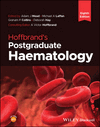Lymphocyte development and function
Sean Hua Lim
Centre for Cancer Immunology, School of Cancer Sciences, University of Southampton, United Kingdom
Search for more papers by this authorSean Hua Lim
Centre for Cancer Immunology, School of Cancer Sciences, University of Southampton, United Kingdom
Search for more papers by this authorAdam J Mead PhD, FRCP, FRCPath, FMedSci
Haematopoietic Stem Cell Biology Laboratory, Medical Research Council Molecular Haematology Unit, Medical Research Council Weatherall Institute of Molecular Medicine, University of Oxford, Oxford, UK
Search for more papers by this authorMichael A Laffan DM, MRCP, FRCPath
Department of Immunology and Inflammation, Faculty of Medicine, Imperial College London, London, UK
Search for more papers by this authorGraham P Collins DPhil, FRCP, FRCPath
Department of Haematology, Oxford Cancer and Haematology Centre, Oxford, UK
Search for more papers by this authorDeborah Hay DPhil, MRCP, FRCPath
Nuffield Division of Clinical Laboratory Sciences, Radcliffe Department of Medicine, University of Oxford, Oxford, UK
Search for more papers by this authorA Victor Hoffbrand MA, DM, FRCP, FRCPath, FRCP (Edin), DSc, FMedSci
Emeritus Professor of Haematology Honorary Consultant Haematologist
University College London, London, UK
Royal Free Hospital, London, UK
Search for more papers by this authorSummary
Functional lymphocytes are the most important elements of an effective immune system. Here, we discuss the key developmental events of the major lymphocyte subsets, T, B and NK cells. In parallel, we will also review how these cells recognise antigen and kill pathogen and rogue cells in infection and cancer. Finally, we will briefly discuss how these specific lymphocyte features can be manipulated for immunotherapy.
Selected bibliography
- Barbet G , Blander JM ( 2018 ) A key ingredient for priming killer T cells . Science 362 ( 6415 ): 641 – 2 .
- Blank CU , Haining WN , Held W et al . ( 2019 ) Defining 'T cell exhaustion' . Nature Review Immunology 19 ( 11 ): 665 – 74 .
- Buchan SL , Rogel A , Al-Shamkhani A . ( 2018 ) The immunobiology of CD27 and OX40 and their potential as targets for cancer immunotherapy . Blood 131 ( 1 ): 39 – 48 .
- June CH , O'Connor RS , Kawalekar OU et al . ( 2018 ) CAR T cell immunotherapy for human cancer . Science 359 ( 6382 ): 1361 – 5 .
- Lim SH , Levy R ( 2014 ) Translational medicine in action: anti-CD20 therapy in lymphoma . Journal of Immunology 193 ( 4 ): 1519 – 24 .
- Melchers F , ten Boekel E , Seidl T et al . ( 2000 ) Repertoire selection by pre-B-cell receptors and B-cell receptors, and genetic control of B-cell development from immature to mature B cells . Immunology Reviews 175 : 33 – 46 .
- Nimmerjahn F , Gordan S , Lux A . ( 2015 ) FcgammaR dependent mechanisms of cytotoxic, agonistic, and neutralizing antibody activities . Trends in Immunology 36 ( 6 ): 325 – 36 .
- Okkenhaug K , Graupera M , Vanhaesebroeck B . ( 2016 ) Targeting PI3K in cancer: impact on tumor cells, their protective stroma, angiogenesis, and immunotherapy . Cancer Discovery 6 ( 10 ): 1090 – 105 .
- Vivier E , Artis D , Colonna M et al . ( 2018 ) Innate lymphoid cells: 10 years on . Cell 174 ( 5 ): 1054 – 66 .



